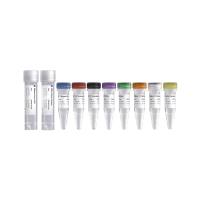Rules of siRNA design for RNA interference (RNAi)
互联网
General Guidelines
- siRNA targeted sequence is usually 21 nt in length.
- Avoid regions within 50-100 bp of the start codon and the termination codon
- Avoid intron regions
- Avoid stretches of 4 or more bases such as AAAA, CCCC
- Avoid regions with GC content <30% or > 60%.
- Avoid repeats and low complex sequence
- Avoid single nucleotide polymorphism (SNP) sites
- Perform BLAST homology search to avoid off-target effects on other genes or sequences
- Always design negative controls by scrambling targeted siRNA sequence. The control RNA should have the same length and nucleotide composition as the siRNA but have at least 4-5 bases mismatched to the siRNA. Make sure the scrambling will not create new homology to other genes.
Tom Tuschl's rules
- Select targeted region from a given cDNA sequence beginning 50-100 nt downstream of start condon
- First search for 23-nt sequence motif AA(N<sub>19). If no suitable sequence is found, then,
- Search for 23-nt sequence motif NA(N<sub>21) and convert the 3' end of the sense siRNA to TT
- Or search for NAR(N<sub>17)YNN
- Target sequence should have a GC content of around 50%
A = Adenine; T = Thymine; R = Adenine or Guanine (Purines); Y = Thymine or Cytosine (Pyrimidines); N = Any.
Rational siRNA design
By experimentally analyzing the silencing efficiency of 180 siRNAs targeting the mRNA of two genes and correlating it with various sequence features of individual siRNAs, Reynolds et al at Dharmacon, Inc identified eight characteristics associated with siRNA functionality. These characteristics are used by rational siRNA design algorithm to evaluate potential targeted sequences and assign scores to them. Sequences with higher scores will have higher chance of success in RNAi. The table below lists the 8 criteria and the methods of score assignment.
A sum score of 6 defines the cutoff for selecting siRNAs. All siRNAs scoring higher than 6 are acceptable candidates.
~undefinedTm = 79.8 + 18.undefinedlog<sub>10([Na+ ] ) + (58.4 * GC%/100) + (11.8 * (GC%/100)2 ) - (820/Length)
For example, the Tm can be calculated as follows for the siRNA UUCUCCAGCUUCUAAAAUA
Tm = 79.8 + 18.undefinedlog<sub>10(0.05) + (58.4 * 31.6/100) + (11.8 * (31.6/100)2 ) - (820/19)
Tm = 32.19
There are two siRNA design tools which implement this siRNA design algorithm: one is offered by Dharmacon, Inc; the other is a downloadable Excel template, written by Maurice Ho at http://boz094.ust.hk/RNAi/siRNA.
References
- Elbashir SM et al. (2001) Duplexes of 21-nucleotide RNAs mediate RNA interference in cultured mammalian cells. Nature. 411:494-498.
- Elbahir SM et al. (2001). Functional anatomy of siRNAs for mediating efficient RNAi in Drosophila melanogaster embryo lysate. EMBO J. 20:6877-6888.
- Elbashir SM et al. (2002). Analysis of gene function in somatic mammalian cells using small interfering RNAs. Methods. 26:199-213.
- Reynolds A, Leake D, Boese Q, Scaringe S, Marshall WS, Khvorova A. Rational siRNA design for RNA interference. Nat Biotechnol. 2004 Mar;22(3):326-30.
- http://www.basic.northwestern.edu/biotools/oligocalc.html
- Maurice Ho, Rational siRNA Design









